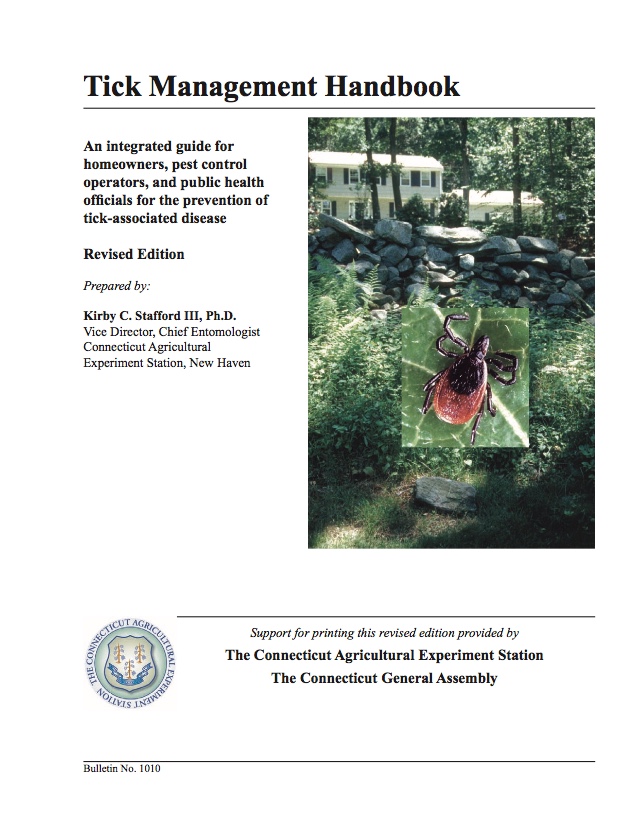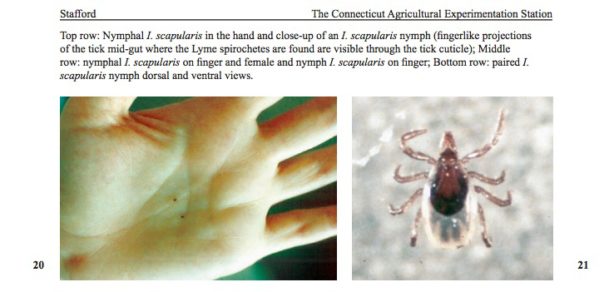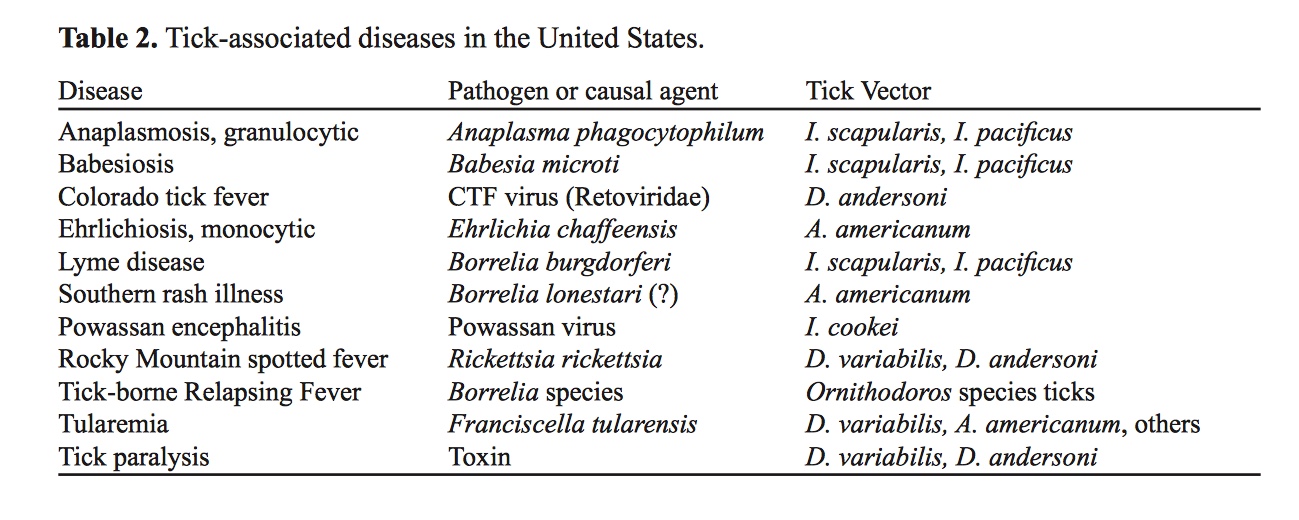World-Class Science To Battle Ticks – Knowledge Is Powerful Ally
It's quite likely that you may never see a tick that can transmit a disease. But to preserve wellness for yourself, your family, companion animals, livestock – arm yourself with world-class science developed over decades of study. A comprehensive book that contains years of distilled facts and scientific observation can help – and it's available as a PDF online from the Connecticut Agricultural Experiment Station (CAES).

This is invaluable guidance for understanding ticks, their life cycle, how to avoid them, and what to do if you find one on you, your family, your companion animals. Image is linked to the downloadable PDF at the Connecticut Agricultural Experiment Station.

See how tiny tick nymphs can be? This is an excerpt from Dr. Kirby Stafford, linked to the PDF from CAES.
For strategy on tick management, indoors and out, the Tick Management Handbook is for parents, homeowners, pest control operators, and public health officials for the prevention of tick-associated disease. Prepared by Kirby C. Stafford III, Ph.D., Vice Director, Chief Entomologist, CAES, New Haven, Connecticut, USA. Dr. Stafford is a medical-veterinary entomologist whose research focuses on the ecology and control of the blacklegged tick, Ixodes scapularis, that transmits the agents of Lyme disease, human babesiosis, and human ehrlichiosis. He also has expertise in the biological control of fly pests of livestock and poultry pest management.
Past research (from CAES bio): “Research in our laboratory and in the field focuses on the ecology and control of the black-legged tick Ixodes scapularis, the tick that transmits the Lyme disease spirochete, Borrelia burgdorferi and the causal agents of human babesiosis and human anaplasmosis. We have investigated the use of landscape methods, least-toxic pesticides, and a parasitic wasp for tick control, the impact of deer exclusion and reduction on tick abundance, and the application of small amounts of pesticide to white-tailed deer or reservoir hosts like white-footed mice and chipmunks for tick control.” He has also assisted with evaluations of canine tick control products.
Current research (CAES bio): Focus on the use of “entomopathogenic fungi and a fipronil-based rodent bait box in an integrated tick management study for the control of the blacklegged tick and examining overwinter survival of the tick under different conditions. In addition, a new project is underway to evaluate the residential efficacy of new reservoir-targeted Lyme disease oral bait vaccine. This approach is anticipated to reduce the prevalence of infection with Borrelia burgdorferi in ticks feeding on the rodent hosts (i.e., white-footed mice and chipmunks), and thereby reduce the infection rate in the tick population and the risk of Lyme disease.”
Science.
——————
Of related interest: Rebecca Tibball, a teacher until impacted by Lyme, recently appeared on a CBS CT morning news show, talking about Lyme disease and an event fundraiser she founded – Teed Off At Lyme Golf Tournament as a way to raise money for Global Lyme Alliance.
“If people can't attend they are more than welcome to donate.”
The tournament was at Shuttle Meadow Country Club in Kensington, CT. Here is the link for information or how to support efforts to raise awareness and help people: https://www.eventbrite.com/e/teed-off-at-lyme-tickets-31415361191.
—————————————–
The mission of CAES is to “develop, advance, and disseminate scientific knowledge, improve agricultural productivity and environmental quality, protect plants, and enhance human health and well-being through research for the benefit of Connecticut residents and the nation.” (By the way, the public is invited to the annual open house Plant Science Day – botany, field trials, insects, management, much information, scientists to meet, beekeeping, gardens, nonprofits as vendors, much more – is Wednesday, Aug. 2, 2017, Lockwood Farm, Hamden. Story about a field trip there, linked here.)
The life cycle of many different ticks (including exotic species, imported by accident) and the many different strains of tick-borne diseases. Before you say “Ick, it's a tick” – pull up a chair and read, read, read. (There are some plants you may want to get rid of in your yard. And sunlight, heat and dry conditions are all things that ticks do not like.)
Tick Bite Prevention Checking for ticks and prompt removal of attached ticks is probably the most important and effective method of preventing infection.
Important points (complete list in PDF report) to consider in tick bite prevention and checking for ticks include:
• Nymphal blacklegged ticks are very small (about the size of a pinhead), difficult to spot, and are active during the late spring and summer months when human outdoor activity is greatest. The majority (about 75%) of Lyme disease cases are associated with activities (play, yard or garden work) around the home.
• Ticks do not jump, fly or drop from trees, but grasp passing hosts from the leaf litter, tips of grass, etc. Most ticks are probably picked up on the lower legs and then crawl up the body seeking a place to feed. Adult ticks will, however, seek a host (i.e., deer) in the shrub layer several feet above the ground, about or above the height of children.
• Children 5-13 years of age are particularly at risk for tick bites and Lyme disease (due to playing outdoors).

Ticks under scrutiny at the CAES microscopes. Get information from science to keep your family and pets well.
• Wear light-colored clothing with long pants tucked into socks to make ticks easier to detect and keep them on the outside of the clothes. Unfortunately, surveys show the majority of individuals never tuck their pants into their socks when entering tick-infested areas. It is unclear just how effective this prevention measure is without the addition of a repellent. Larval and nymphal ticks may penetrate a coarse weave sock. Do not wear open-toed shoes or sandals.

A pen at left is shown for scale as these containers hold larval and nymphal deer ticks – and they are tiny, tiny, tiny. As seen at the CAES Plant Science Day. CB/MDP photo
• DEET or permethrin-based mosquito and tick repellents may be used, which can substantially increase the level of protection (see section on repellents). This approach may be particularly useful when working in the yard, clearing leaves, and doing other landscaping activity with a high risk of tick exposure. A separate set of work or gardening clothes can be set aside for use with the permethrin-based clothing tick repellents.
• Carefully inspect the entire body and remove any attached ticks. Ticks may feed anywhere on the body. Tick bites are usually painless and, consequently, most people will be unaware that they have an attached tick without a careful check. Also, carefully inspect children and pets. Take notice of the proximity of woodland edge or mixed grassy and brushy areas from public and private recreational areas and playing fields. While ticks are unlikely to be encountered in open fields, children chasing balls off the field or cutting through woods to school may be entering a high-risk tick area.
• Pets can bring ticks into the home, resulting in a tick bite without the person being outdoors. A veterinarian can suggest methods to protect your pets. Engorged blacklegged ticks dropping off a pet will not survive or lay eggs in the house, as the air is generally too dry. For a page of other helpful tick-related publication available, here is the link to the CAES page.
—————————–
For information about a slew of tick-borne diseases and how they relate to canines from a personal perspective, see this link https://sites.google.com/site/tickbornediseaseindogs/. “A great deal of whatever good and useful information there is on this site is attributable to Dr.Tom Beckett who has treated more dogs with TBD over the years than he probably cares to think about. I am endlessly grateful for his help.” References are linked in the text. The creator of the site is Gil Ash, who lost a dog to the “ravages of chronic Neorickettsia risticii, once known as Erhlichia risticii. He was not even three when he died, the best dog I've ever owned, and I watched him die by inches over the course of a year and a half. Here in the deep South, where ticks are right at home, no one recognized tick disease until it was too late to save him.” (While all was written years ago, the facts remain true and may be helpful for others.)


